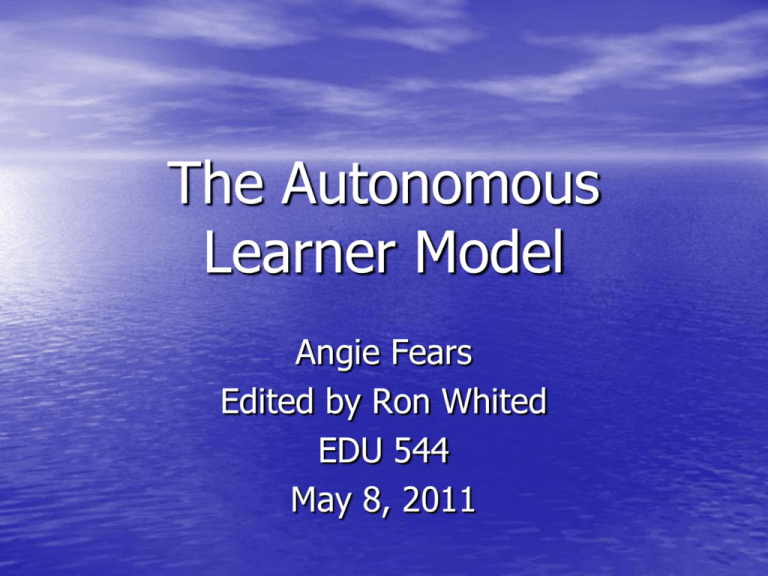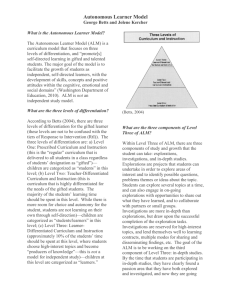
The Autonomous
Learner Model
Angie Fears
Edited by Ron Whited
EDU 544
May 8, 2011
Presentation Overview
•
•
•
•
•
•
•
•
•
•
•
Origins of the ALM
Autonomous Learner Defined
Goals of the ALM
Overview of the ALM
From the First to the Fifth Dimension
Two Important Distinctions in Terminology
Activities for Transforming Student to Learner
Torrance’s Teachings
Applications of the ALM
Last Thoughts About the Life-Long Learner
Bibliography
Where did the ALM come from?
• 1973, Arvada West High School, Arvada, Colorado
• George Betts – background in psychology & counseling
• Jolene Kercher – mathematics teacher
George Betts
• New project that targeted achieving and non-achieving gifted students
• Instructed to:
• modify the system, not the students
• develop the program with the students, not for them
• be facilitators of learning and not dispensers of knowledge
• First publication of the Autonomous Learner Model in 1981 by Betts and Knapp
• Evaluated and revised in 1996 to better meet diversified needs
• Based on consultation with national leaders, reviews of pertinent literature, the
training of teachers, and the experiences of learners, teachers, administrators,
and parents who worked together to build a new approach that would meet the
diversified needs of learners.
What is an autonomous learner?
“…one who solves problems or develops
new ideas through a combination of
divergent and convergent thinking and
functions with minimal external guidance
in selected areas of endeavor.”
(Betts and Knapp, 1981)
Definition of terms;
• Giftedness- Gifted and talented children are those
•
identified by professionally qualified people, who by
virtue of outstanding abilities, are capable of high
performance. These are children who require
differentiated educational programs and/or services
beyond those normally provided by the regular school
program in order to realize their contribution to self and
society.
Intelligence- intellectually gifted students who have
abilities superior to other children in the school systems.
They are recognized as having a storehouse of
knowledge. Curiosity and large variety of interests are
supported by these learners capacity for processing
information. Intelligence is measured by IQ testing.
Definition of terms continued;
• Creativity- The creatively gifted have creative, out of
•
the box thinking abilities which are superior to other
children in the school system. Their acute senses of
humor and slight tolerance for boredom are amplified by
their spontaneity and expressive demeanor. Often
unable to stay on task and often are not teacher
pleasers.
Talent- the talented have developed one specific are in
which they excel. Their ability is focused on that one
area and is not as global as the learner with intellectual
and creative abilities. The talented learner possesses a
very strong drive or motivation to devour everything
about the area of interest. A lifelong passion.
What are the goals of the ALM?
• To have students become independent,
creative, responsible learners
• To help students develop a positive selfconcept and social skills
• To increase students’ knowledge base,
independence, and ability to make
decisions and find creative solutions to
problems
DIMENSION ONE:
ORIENTATION
AREA 1: Understanding Giftedness, Talent, Intelligence, & Creativity
-Learners, teachers, administrators, & parents develop foundation of concepts
-Theories & definitions followed by discussion & activities
AREA 2: Group Building Activities
-Group process, group roles, group strategies to foster ability to work together
-Learn group-dynamic skills & how to facilitate positive, nurturing environment
AREA 3: Self/Personal Development
-Explore & answer questions that increase understanding of self
-Addresses self-concept, self-esteem, understanding of gifts/talents/weaknesses,
how to develop abilities, etc.
AREA 4: Program & School Opportunities & Responsibilities
-Learn & discuss ALM
-Comprehend difference between student & learner; teacher & facilitator
-Explore ways to be involved in the school and community
DIMENSION TWO:
INDIVIDUAL DEVELOPMENT
AREA 1: Inter/Intra Personal
-Extension of Self/Personal Development from ORIENTATION
-On-going pursuit of the development of self-concept, self-esteem,
& skills to interact effectively with others
AREA 2: Learning Skills
-Study skills that are more individualized; academic skills that are content specific
-Bloom’s Taxonomy used as basis for teaching thinking skills
-Critical & creative thinking, problem-finding & problem-solving also included
AREA 3: Technology
-Gather information through use of computers, internet, CD Rom, etc.
-Emphasis on each learner’s ability to synthesize that information with
experience & previous knowledge
AREA 4: College and Career Involvement
-Complete post-high school and career-planning questionnaires
-Gain information about colleges, explore career options
-Practice interviews; complete applications & resumes
AREA 5: Organizational Skills
-Learn different methods of organization & develop approach for themselves
-Life management as well as day-to-day organization
-Daily, monthly, & yearly Life-Management Wheels facilitate self-understanding
DIMENSION THREE:
ENRICHMENT
AREA 1: Explorations
-Short-term and on-going
-Goal is to find out what is out there
-Find new & unique knowledge using a variety of methods
AREA 2: Investigations
-Follow successful completion of several explorations
-Steps & skills necessary for independent inquiry are directly taught
-Must design, implement, complete, & present project with a mini-product
AREA 3: Cultural Activities
-Learners go beyond the scenes to learn more than they normally would at
a museum, play, dance recital, etc. by coming prepared with questions and
meeting the people involved before or after the activity
AREA 4: Service
-Activities provide opportunities to understand self & relationship with others
-Learn about humanitarianism & its impact on society
-Essential and non-negotiable
AREA 5: Adventure Trips
--Purpose is for learners, interested parents, & teachers to work together to
plan a meaningful trip (day, week, or longer)
-3 components: preplanning, trip participation, & assessment of experience
DIMENSION FOUR
SEMINARS
Designed for students to demonstrate their ability to be
learners & to work together in small groups
-Students are now operating in the role of learners
-Teachers are now facilitators of the learning process
Seminars consist of:
-Selection of a topic of importance to the learner
-Development of the basic seminar (2 weeks to do)
-Presentation of the seminar (may take 30 minutes to an hour)
-Assessment of the seminar by learner, teacher, & other class members
Seminars focus on the following areas:
1. Futuristic
2. Problematic
3. Controversial
4. General interest
5. Advanced knowledge
DIMENSION FIVE
IN-DEPTH STUDY
Component 1: Individual or Group Projects
-Students now possess skills, concepts, & attitudes necessary
to function as true learners; teacher is facilitator of learning process
-Most students elect to work alone; groups should be no larger than 3 learners
-Students have successfully completed Explorations, Investigations, & Seminars
Component 2: Mentorships
-Whenever possible, learners are encouraged to work with mentors
-Learners at high school level seek their own mentors because they are now
functioning as autonomous learners.
Component 3: Presentations
-Presentations of In-Depth Studies are essential
-Short presentations are given throughout grading period
-Final presentation is made at conclusion of the study
-which may last 2-months to 2 years)
Component 4: Assessment
Autonomous=able to plan a project, participate in the project,
complete the project, & assess the project
-Assessment of the learner, the process, & the product are integral to ALM
The ALM makes two important
distinctions in terminology:
• Student vs. Learner
Students rely on teachers to tell
them what they need to know
Learners pursue their passions by
seeking knowledge and
developing their skills
• Teacher vs. Facilitator
Teachers dispense knowledge
Facilitators support &
encourage the learning process
There are three 3 essential levels of learner
differentiated curriculum within the ALM. These
activities help transform students into learners.
Explorations
Investigations
In-Depth Study
Student based
Student/learner based
Learner based
Diverse possibilities
Diverse possibilities
In-Depth possibilities
Short term
Longer term
Long term
Information gathering;
Learning evident (knowledge
Passion discovery
Passion development
Multiple means of reporting
Multiple means of reporting
Presentation & assessment
of learner and product
Emphasis on content
Emphasis on content &
process
Emphasis on content,
process, & product
DIMENSION THREE:
ENRICHMENT
DIMENSION THREE:
ENRICHMENT
DIMENSION FIVE:
IN-DEPTH STUDY
& comprehension)
Teachings of Dr. E. Paul Torrance (1983) have
been incorporated into the ALM to help students
move in the direction of becoming life-long
learners. They include:
1.
2.
3.
Don’t be afraid to fall in love with something and pursue it with
intensity and depth.
Know, understand, take pride in, practice, develop, use, exploit,
and enjoy your greatest strengths.
Learn to free yourself from the expectations of others and to walk
away from the games that others try to impose upon you. Free
yourself to “play your own game in such a way that you make
good use of your gifts. Search out and cultivate great teachers or
mentors who will help you accomplish these things” (p. 78)
Where and when can the ALM be used?
• Originally developed for high school gifted students
• Then modified for middle school gifted students
• Now can be used with students as young as kindergarten
• Betts and Carey propose an RtI & ALM Curriculum that:
–
–
–
–
–
–
–
Includes the Intellectual, Emotional, & Social domains of the learner
Develops the strengths and abilities of the individual
Includes all Five Dimensions of the ALM
Includes areas within all Five Dimensions of the ALM
Includes Content + Process + Product = Learning Experience
Includes Universal, Targeted, & Intensive Levels according to RtI
Aims toward the goal of developing each student as an autonomous
learner
So, what do we know about life-long learners?
“A life-long learner is one
who loves the moment,
seeks truth, friendship,
knowledge and wisdom.
This person accepts self and others,
and realizes the chance to make this a
better world.
A lifelong learner discovers new paths
for growth, joy,
knowledge and friendship.
the journey begins today…”
(Betts 2003)
Bibliography
• Betts, George T. “The Autonomous Learning Model for High School Programming.
Gifted Education Communicator, Fall/Winter 2003.
• Betts, George T. “The Autonomous Learner Model for the Gifted and Talented”
presented by George T. Betts,
www.muw.edu/ccl/presentations/TheAutonomousLearnerModelforGifted_files/frame.htm.
• Betts, G. and Neihart, M. “Profiles of the gifted and talented.” Gifted Child Quarterly,
1988.
• Carey, Robin and Betts, George. A Complete Approach for the Gifted: Response to
Intervention (RTI) and the Autonomous Learner Model (ALM).
www.alspublishing.com.
• Clark, Barbara (2008) Growing Up Gifted -7th Edition. Pearson Prentice Hall, pp. 424426, 438, 443.
• DeLisle, James R. (2006) Once Upon a Mind: The Stories and Scholars of Gifted
Child Education, Wadsworth, pp. 232-235.








